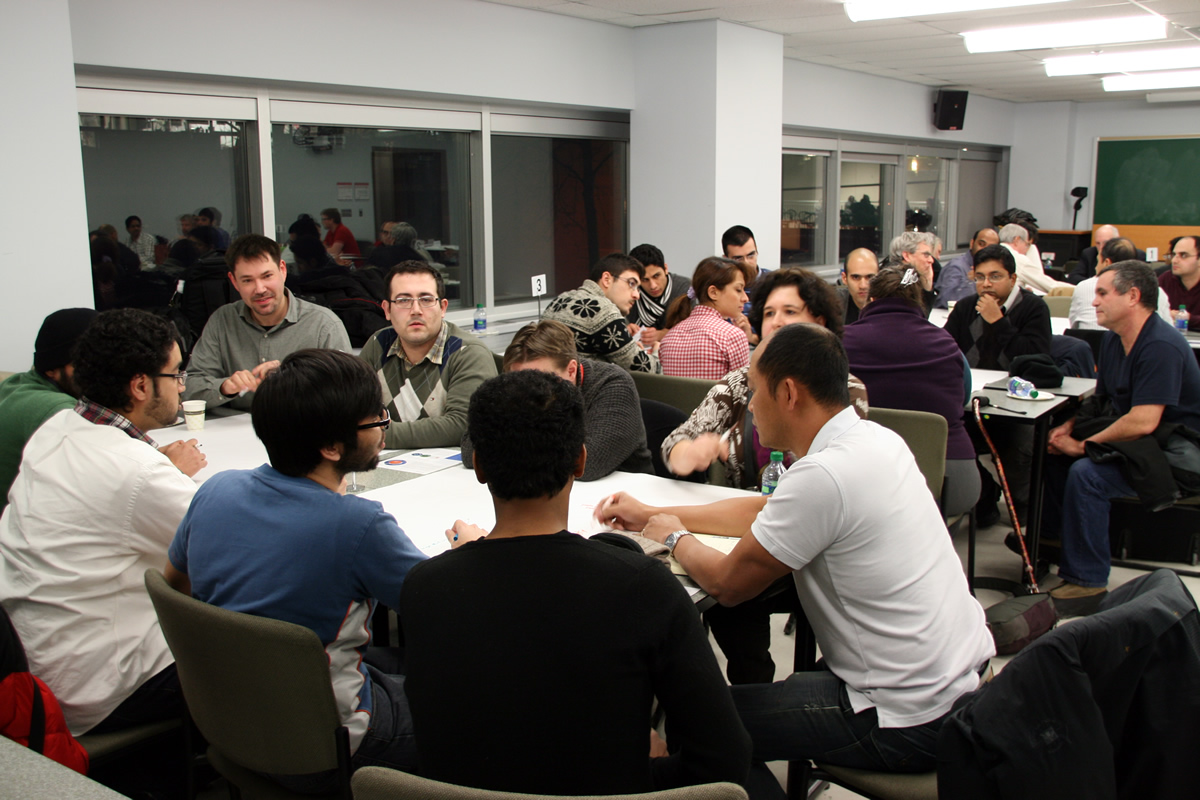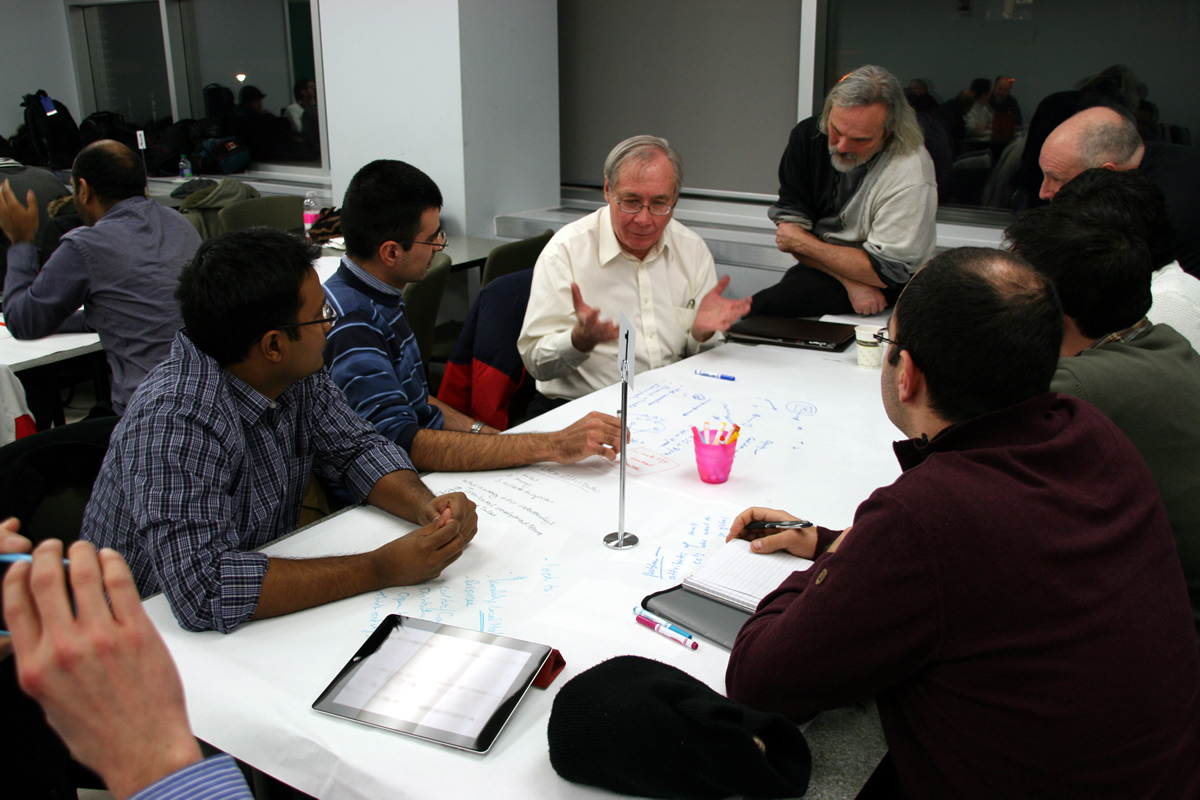Open innovation is the formal discipline and practice of leveraging the discoveries of unobvious others as input for the innovation process through formal and informal relationships.
Frank Piller
Professor of Technology & Innovation Management
Overview
The second TIM lecture of 2013 was presented by Christophe Deutsch and Philippe Dancause, co-founders of En Mode Solutions, a new startup that has arisen through the development of the Seeking Solutions approach to local open innovation. The lecture provided the opportunity for the audience to not only learn about this new approach to open innovation, but also to experience it through an interactive session. The event was held at Carleton University in Ottawa, Canada, on February 7th, 2013.
The TIM Lecture Series is hosted by the Technology Innovation Management program at Carleton University. The lectures provide a forum to promote the transfer of knowledge from university research to technology company executives and entrepreneurs as well as research and development personnel. Readers are encouraged to share related insights or provide feedback on the presentation or the TIM Lecture Series, including recommendations of future speakers.
Summary
In the first half of the event, Deutsch and Dancause provided an overview of the benefits and barriers of open innovation generally, then described how a new approach – local open innovation – could help companies solve particularly challenging business problems that they have been unable to solve on their own. For the second half of the event, the room was reconfigured to suit an interactive session that would reinforce the insights from the lecture through hands-on experience. Audience members became participants in local open innovation as either problem owners or problem solvers.
Part I: Local Open Innovation
To explain the differentiating features of their approach, Deutsch and Dancause first built up the term "local open innovation":
- At the heart of the approach is innovation, which they defined as "disciplined problem solving".
- By opening up a problem to outsiders and thereby bringing new knowledge to bear on a challenge, open innovation increases the productivity of problem-solving tasks. Here, Deutsch and Dancause stressed the importance of fostering: i) input from "unobvious" sources; ii) informal relationships and interactions; and iii) serendipity. These elements open the innovation process to encourage new ideas, new visions, and breakthroughs.
- Although open innovation typically operates over a large geographical scale, often exclusively using Internet platforms, the levels of interaction and collaboration between problem owners and problem solvers is low. By operating at a local scale, local open innovation takes advantage of proximity, both in terms of enabling face-to-face interactions between collaborators and in terms of bringing together diverse "neighbours" who might not otherwise discover each other's capabilities.
Next, Deutsch and Dancause described the four key steps involved in the Seeking Solutions approach to local open innovation:
- The call for problems: the organizers reach out to companies and encourage them to submit challenging business problems they have been unable to solve.
- Problem selection: the organizers select and refine appropriate problems.
- Problem broadcast: through broad and targeted means, the problems are distributed to potential problem solvers.
- The collaborative event: problem owners and problem solvers come together to further understand the problems and develop solutions during a full-day collaborative event, with support and facilitation provided by the event organizers.
Further details of the approach and its development, including results from past events, are provided in this issue of the TIM Review by Deutsch (2013) and Berger Masson (2013).
Lessons learned
In the discussions that followed the first part of the presentation, audience members shared the lessons they learned from the presentation and injected their own knowledge and experience into the conversation. The speakers and audience members also identified the following key takeaways from the presentation.
General insights about open innovation:
- Most companies are looking for problems they can apply their solutions to. Open innovation turns this perspective around, and thus it requires a change in mindset. In fact, open innovation is more about a mindset change than a process change.
- Open innovation requires a balance between the formal aspect of managing openness (and related processes) and the informal aspect of being receptive to new ideas.
- Many service providers think they can do "something" for a potential customer, but they do not always have a clear answer as to what that might be. Equally, every company has its own knowledge of its problems and its own capability to solve them. With virtual interactions alone, it can be difficult to bridge these gaps; it requires problem solvers to gain a deeper understanding of a company's problems and a means to demonstrate their capabilities in a direct manner that is relevant to an existing problem.
- Organizers need to harness the "Power of Q" (Uzzi and Spiro, 2005), which means striking the optimal balance between "outsiders" and people who are already used to working together. A local approach to open innovation helps increase the intimacy of the collaboration by ensuring the group is not too diverse.
Specific insights about the Seeking Solutions approach to local open innovation:
- In Seeking Solutions events, the business aspects become secondary to the creative challenge of solving the problem. Thus, problem solvers are not concentrating on "selling their stuff"; instead, they are driven by the problem. This environment is beneficial for all parties. Problem solvers can effectively demonstrate their relevant capabilities; problem owners receive focused attention on their actual problems.
- Both problem owners and problems were willing to pay to attend the events. Fees for problem solvers ensured that there would be no "passengers"; only committed participants would be in attendance.
- Problem owners gain benefits beyond any new solutions that may arise: they receive help in better defining their problem, better understanding their problem, and validating any existing solutions they are considering. Better-defined problems to help solve also benefit the problem solvers.
- Beyond the actual problem-solving activities, participants greatly appreciated the events as a unique, high-value networking opportunities.
- The role of the facilitation team is very important. People may be outside their comfort zones, and an open, playful, and creative atmosphere must be created to encourage the flow of new ideas.
- Contrary to expectations, intellectual-property issues did not arise during the events; this was possibly due to an expectation of openness among all participants. Legal aspects seem to emerge later, only once the proposed solutions become more concrete.
- Local open innovation has benefits for economic development: it creates value in the region and builds connections between industries.
Part II: A Taste of the Seeking Solutions Approach
In the second part of the lecture, Deutsch and Dancause put some of aspects of the Seeking Solutions into practice by asking the audience to participate in an interactive session of local open innovation. Due to time constraints, the session compressed or skipped over key steps in the process, but the intention was just to give audience members "a taste" of the approach.
Box 1 lists the problems that audience members proposed and were selected for the interactive session. In contrast to full Seeking Solutions events, the session focused on non-technical problems, most of which were general (i.e., there was no single or "true" owner of a given problem). Equally, the problem solvers did not know what problems would be proposed; they were not in attendance because they had any particular affinity to a particular problem, nor did they pay to attend the event. These and other differences meant that the interactive session would just "skim the surface" of the overall approach, but it was hoped that the session would be realistic enough to show how such an event could help problem owners and problem solvers collaborate around challenging problems.
|
Box 1. Problems put forth by TIM Lecture participants
|
Each problem owner was assigned a table in the room and the other participants (i.e., the problem solvers) were asked to sit at the table with the problem that most interested them or to which they felt they could add the most value (Figures 1 and 2). Deutsch and Dancause facilitated the event by guiding the problem owners and problem solvers through a series of questions designed to help everyone understand the problem and then start contributing novel solutions to it:
- What is the problem and why does it need an answer?
- What is missing in our understanding of the problem?
- What are the new ideas that may help solve the problem?
- Problem solvers move to a new table, then question 3 is repeated.
- Problem solvers return to their original table, then question 3 is repeated again.
- What are the best leads and what should the next steps be?
Figure 1. Participants in the TIM Lecture interactive session on the Seeking Solutions approach to local open innovation
Figure 2. To a group of problem solvers, Dr. Tony Bailetti describes the challenges technology startups face when trying to globalize early and rapidly
Participant feedback
Despite key differences between the one-hour session and a full Seeking Solutions event, the TIM Lecture participants contributed enthusiastically and gave the following, largely positive feedback on the experience:
- "This felt awesome. And the results were awesome."
- "Although we were pretty much a group of total strangers, we immediately became very engaged around the problem."
- "Our problem was large and complex. However, as we worked through it, we uncovered smaller sets of problems that, by being solved, could greatly contribute to solving the overall problem."
- "Unfortunately, we spent a lot of time returning to the original question and trying to redefining it, rather than understand it. So, we were really starting to solve a different problem than the one I originally proposed."
- "It didn't take us long to realize that we had a table full of very smart people, ready to work together."
- "As the 'owner' of the problem, I am quite satisfied with the quality of the discussion and the outcome in terms of next steps. I would not have been able – on my own – to do such a thorough analysis of the problem, as complete an identification of potential solutions, or as relevant zeroing-in on initial first steps toward addressing the problem."
- "The problem has not been solved, but we managed to find a good direction to move forward, and we confirmed what we think needs to be done."
- "I personally think the value lies in the people around the table with similar interests in terms of wanting to find a solution to the problem at hand. It not only redefines and perfects the question at hand, it brings about solutions to secondary problems lurking in our minds."
- "Progress was made by providing: i) a better understanding of the problem and ii) actionable next steps."
- "It was great to start with brainstorming on the true or underlying problems from a variety of perspectives. Thereafter, the juxtaposition, combination, and collision of perspectives, ideas, and options makes it possible to ascertain quickly what holds water and what doesn't, what might be feasible or not, and what conditions must be met to ensure viability."
This report was written by Chris McPhee, with photographs by Yahya Baby.
Keywords: local open innovation, Open innovation, Quebec Seeks Solution, Seeking Solutions


